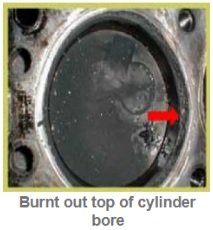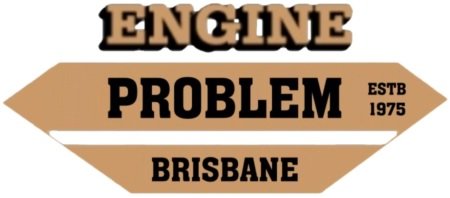Block Engine Problem
To assist us in correctly diagnosing the type of Cylinder Block problem you are experiencing, please select the correct menu item.
The site will show you your required checks & common issues with cylinder blocks. Show you how to diagnose & repair your worn out, cracked, corroded, or even bent cylinder blocks.
Please visit our Engine Assembly page for block assembly tips

Block engine problem - BENT / MISALIGNED / WARPED
Two places on an O.H.C. block to be checked for straightness and misalignment are the block face and the Main bearing tunnels. If the block has camshaft or balance shaft tunnels, these areas also require close inspection. Line boring of a block camshaft bearing tunnels will depend upon the availablity of o/sized backed Cam bearings being available.
The face of the block requires a surface grind when the finish or flatness becomes unacceptable to provide a secure sealing surface for the head gasket. Another position on the block face that requires close inspection is around the threaded head stud area. This area quite often becomes raised due to the clamping force required to seal the head gasket.
The main tunnel has to be straight. The main bearing tunnel inside diameters have to be within tolerances. If these problems exist the block will require a tunnel bore. This is a considerably complex machining procedure but is essential to the performance of the main bearings. The misalignment occurs when the block shifts. This may come about from normal use but again is accelerated by engines operating outside their ideal maximum temperatures and loads.
Large diesel engines suffer this problem the most and line boring is considered a standard machining process during reconditioning. Most times a tunnel line hone will correct minor misalignment. A good quality straight edge and inside micrometers are used to determine the integrity of the main tunnels.
: Every care has been taken in writing this information and procedures, but no responsibility can be excepted for errors, omissions or misuse of this information and procedures. The information available on this site is for your instruction only and cannot be copied for sale, © copyright 2020 UMR Engines www.engineproblem.com.au

Block engine problem - BURNT OUT
This is a problem that occurs more with diesel engines than petrol engines. The effected area is at the top of the bore.
The bore and flame ring if applicable will have the appearance of being burnt away with an oxy. The block will require sleeves to be fitted. Quite often the problem has existed for so long the damage is outside the limits that available sleeves will repair, so the block is U/S. The main cause of this occurrence in diesel engines is a leaking injector ,faulty injector pump or incorrect injector pump timing.
The problem in diesel engines quite often goes unnoticed until the engine is stripped down for a rebuild. By this time the compression is low and the engine has developed a misfire, has blow by and visible exhaust smoke.
This condition is caused by excessive combustion temperatures. The cooling system on a diesel is usually fairly over sized and efficient so the problem is not reflected in the temperature of the coolant. That is the main reason why the malfunction goes unnoticed even though loss of engine power, black exhaust smoke and excessive diesel knock usually accompanies this condition.
: Every care has been taken in writing this information and procedures, but no responsibility can be excepted for errors, omissions or misuse of this information and procedures. The information available on this site is for your instruction only and cannot be copied for sale, © copyright 2020 UMR Engines www.engineproblem.com.au

Block engine problem - CORROSION / HOLE IN
The most common cause of a hole in the side of a block is a broken conrod. See BROKEN/conrod.
The block damage is sometimes confined to the crankcase area and is quite repairable. Damage usually extends to an oil gallery or water jacket and this usually renders the repair uneconomical and block replacement is a better option. A pin hole in the bore is another common problem. This is usually repaired by fitting a sleeve. See BLOCK/cracked for more information.
The problem with a corrosion pin hole is that the state of the apparently unaffected bores is an unknown quantity. Corrosion is a methodical, chemical etching away of the parent material. The bore that has the pin hole should be inspected closely to determine how bad the corrosion is. If it is extreme in that bore there is a good chance that the others are very close to doing the same. Therefore a decision to replace the block or to sleeve all cylinders has to be considered. Diesel with wet liners suffer from erosion of the liners.
Cavitation Erosion is a totally different process. This is caused by the entrapment of tiny air bubbles in the cooling system and their subsequent action on the liner. The tiny vapour bubbles are formed by the mechanical vibrations caused by combustion and the action of the piston slapping against the bore. The action of the vapour bubbles imploding against the inside of the liner cause cavitation erosion.
The outside of the liner usually has a position covered in many small perforated holes or pit marks. Factors that increase the action of cavitation erosion are cooling system pressure loss, the induction of air and overheating.
Petrol engines don't suffer the effects of cavitation erosion the same as diesel's, because combustion pressures and harsh piston contact are much less in petrol engines compared to diesel engines. Petrol engines suffer more from hot spot boiling erosion damage. See Procedures section / Radiator Coolant.
: Every care has been taken in writing this information and procedures, but no responsibility can be excepted for errors, omissions or misuse of this information and procedures. The information available on this site is for your instruction only and cannot be copied for sale, © copyright 2020 UMR Engines www.engineproblem.com.au

Block engine problem - CRACKED
Blocks crack for similar reasons as cylinder heads do. Like heads, some particular blocks are prone to cracks in certain areas and tend to do so at every overheat.
Cracks out of head bolt locations running to the water-jacket are common in many engines. The problem with these cracks is that water can find its way up the cracked thread to the top of the head stud or bolt. Depending upon the position and style of block these cracks can be repaired by the use of a solid thread insert and a few crack repair plugs. The block face must be surfaced ground after this repair.
Cracks between cylinders are usually fairly serious and have to be correctly repaired. The crack should be repaired with suitable crack repair plugs close to each cylinder so the sleeve picks up the edge of the crack repair plug. Selection of sleeves should be of a wall thickness that allows the sealing ring of the head gasket to seal directly on the top surface of the sleeves. The sleeves should be fitted into a stepped bore to ensure the sleeve does not move down in service. The block face should be surface ground or milled. Adjacent cylinders to the sleeved bores should be re-honed to remove any ovality created by the interference fit of the sleeves.(.05 to .1 of a MM. or 2 to 4 thousandths of an inch.) A suitable coolant sealer should be introduced to ensure complete sealing during initial warm up. The engine should be driven to normal operating temperature and let cool a couple of times before removing the sealer and adding the correct amount of radiator coolant.
Cracks between Welsh plugs are another very common defect that occurs consistently to specific engines. Some manufacturers have design problems that are considered responsible for this failure. The truth is that the blocks are simply made too weak and require extra ribbing in this area. Due to the design of these blocks it is almost impossible to repair these cracks and sustain a 100% seal. They can be repaired successfully but you normally have to be content to suffer a little weeping and staining at the repaired area. The repair procedure is more successful when solid core plugs are introduced so the crack repair plugs can be stitched along the cracks and into the edge of the solid plug. The cracks require the fitting of several cross locks to stabilise the block. The use of straight plugs against tapered plugs appears to be slightly more successful in this repair. Again the introduction of a good quality sealer before inhibitor will give better results.( this repair often suffers staining from inhibitor creep)
Cracked bores are more common in some particular V8 engines than others but all engines can suffer this problem if overheated. These cracks are successfully repaired by sleeving as described in "cracks between cylinders".
Cracks to oil galleries are not as common and are usually only minor. A localised cast iron weld will normally fix this problem. The block should be pre heated and allowed to slowly cool. Some peening of the welded area and a pressure test will check the integrity of the repair.
: Every care has been taken in writing this information and procedures, but no responsibility can be excepted for errors, omissions or misuse of this information and procedures. The information available on this site is for your instruction only and cannot be copied for sale, © copyright 2020 UMR Engines www.engineproblem.com.au

Block engine problem - WORN OUT
Evenly worn out bores are a normal condition after considerable use. Abnormal excessive wear can occur for the same reasons as stated in PISTON - Worn Out. See PISTON - WORN OUT
One worn bore, especially if it is close to the water pump or the returned water from the radiator indicates that the engine is running without a thermostat. This abnormally worn bore will be running too cold. As most wear occurs during cold start up and before normal operating temperature is reached. The removal of a thermostat will accelerate bore wear in the coldest cylinder.(or a stuck wide open or modified thermostat.) Thermostats can fail either stuck closed or stuck fully open. Unfortunately the stuck fully open position quite often goes unnoticed by the driver as the engine damage may not be as sudden, but long term it is terminal.
Ring spin causes severe localised wear at the top or bottom of the bore. It is usually more pronounced at the bottom where less pressure is forced on the rings. Ring spin is usually a result of Unidirectional Honing. This hone pattern moves the ring around the piston during its travel up and down the bore. When the piston ring reaches bottom dead centre little or no pressure is applied to the ring so it can keep turning or spinning while the piston stops to change direction. This problem will cause pre-mature wear and is very easily recognisable upon strip down.
: Every care has been taken in writing this information and procedures, but no responsibility can be excepted for errors, omissions or misuse of this information and procedures. The information available on this site is for your instruction only and cannot be copied for sale, © copyright 2020 UMR Engines www.engineproblem.com.au
